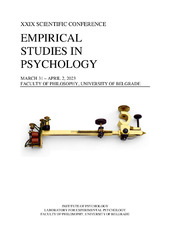Приказ основних података о документу
Depression in older adults: testing the behavioral model
| dc.creator | Dimoski, Jana | |
| dc.creator | Vukčević Marković, Maša | |
| dc.creator | Džamonja Ignjatović, Tamara | |
| dc.date.accessioned | 2023-11-24T12:38:50Z | |
| dc.date.available | 2023-11-24T12:38:50Z | |
| dc.date.issued | 2023 | |
| dc.identifier.isbn | 978-86-6427-247-6 | |
| dc.identifier.uri | http://reff.f.bg.ac.rs/handle/123456789/5402 | |
| dc.description.abstract | Depression is the most frequent mental health disorder in older adults and is often underdiagnosed and undertreated. The behavioral model of onset and maintenance of late-life depression (Fiske et al., 2009) is the only one depicting depression in the elderly, even though it has not been previously operationalized and tested, nor it included any protective factors. First, the aim of the study is to test the original behavioral model, and the model supplemented with protective factors. Secondly, the aim is to compare the relative contribution of each predictor in the models, with depression set as a criterion variable. The sample was convenient and it consisted of 225 older adults (Mage = 73.5; SDage = 6.01; 30% males) from 13 cities in Serbia. The participants filled out 12 questionnaires face-to-face with the help of trained interviewers (HEXACO Emotionality, Coping Inventory for Stressful Situation, Experiences in Close Relationships, Meaning in Life Questionnaire, Duke Social Support, Geriatric Depression Scale, Self-critical Cognitions Scale, The Environmental Reward Observation Scale as well as questionnaires designed for the purpose of this study – Limitation of activities Scale, Stressful Life Events Scale and Changes in Health Scale and Questionnaire on Sociodemographics; α = .55 - .87). In total, 32% of older adults had clinically indicative symptoms of depression (20.8% mild, and 10.2% severe). Neither the original [χ 2 (71) = 265.441, χ 2 /df = 3.739, p = .000, CFI = .69, NFI = .64, RMSEA = .11, TLI = .55], nor supplemented behavioral model of depression [χ 2 (89) = 347.611, χ 2 /df = 3.906, p = .000, CFI = .70, NFI = .65, RMSEA = .11, TLI = 0.54] showed acceptable model fit in structural equation modeling. Nonetheless, the linear regression model is tested to compare the relative contribution of predictors, and explained 56% of the variance in depression (R 2 adj = .56; F(12) = 22.162, p < 001), where it was shown that significant predictors were emotional coping (β = .25, p < 001), subjective social support (β = -.25, p < .001), the meaning of life (β = -.24, p < .001), socio-economic status (β = -.17, p < .05), avoidance coping (β = -.16, p < .01), and anxious adult attachment (β = .14, p < .05). This study provides an evidence-based starting point for further research on behavioral models and on conceptualizing alternative models of depression in older adults. It provides insights into the predictor structure of depression in the elderly and is focused on providing recommendations for psychosocial practice. | sr |
| dc.language.iso | en | sr |
| dc.rights | openAccess | sr |
| dc.rights.uri | https://creativecommons.org/licenses/by/4.0/ | |
| dc.source | Book of Abstracts, XXIX Scientific Conference Empirical Studies in Psychology, March 31-April 2, Faculty of Philosophy, University of Belgrade | sr |
| dc.subject | depression | sr |
| dc.subject | older adults | sr |
| dc.subject | behavioral model | sr |
| dc.title | Depression in older adults: testing the behavioral model | sr |
| dc.type | conferenceObject | sr |
| dc.rights.license | BY | sr |
| dc.citation.spage | 129 | |
| dc.identifier.fulltext | http://reff.f.bg.ac.rs/bitstream/id/13561/EIP2023_book_of_abstracts.pdf | |
| dc.identifier.rcub | https://hdl.handle.net/21.15107/rcub_reff_5402 | |
| dc.type.version | publishedVersion | sr |

